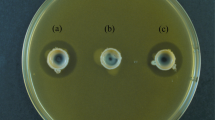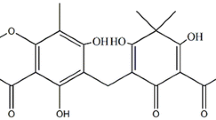Abstract
A lactic acid bacterial strain was isolated from human fecal specimen and identified as Enterococcus faecalis SL-5. The isolated strain showed antimicrobial activity against Gram-positive pathogens assayed, especially the highest activity against Propionibacterium acnes. The antimicrobial substance was purified and verified as a bacteriocin (named ESL5) of E. faecalis SL-5 by activity-staining using P. acnes as an indicator. N-terminal sequence of ESL5 was determined (MGAIAKLVAK) and sequence analysis revealed that it is almost identical to the some of enterocins including L50A/B of E. faecium L50 and MR10A/B of E. faecalis MRR 10-3. From the sequencing data of L50A/B structural genes, the nucleotide sequence showed 100% identity with that of the MR10A/B structural genes, implying that ESL5 is an equivalent of enterocin MR10. Meanwhile, we also tested the therapeutic effect of anti-P. acnes activity in patients with mild to moderate acne because of its pathogenic role to acne vulgaris. For this purpose, a concentrated powder of CBT SL-5 was prepared using cell-free culture supernatant (CFCS) of E. faecalis SL-5 and included in a lotion for application in the patients. The study showed that CBT SL-5 lotion significantly reduced the inflammatory lesions like pustules compared to the placebo lotion. Therefore our results indicate that the anti-P. acnes activity produced by E. faecalis SL-5 has potential role to the treatment of acne as an alternative to topical antibiotics.
Similar content being viewed by others
References
Amenta, M., M.T. Cascio, P. Di Fiore, and I. Venturini. 2006. Diet and chronic constipation. Benefits of oral supplementation with symbiotic zir fos (Bifidobacterium longum W11+FOS Actilight). Acta Biomed. 3, 157–162.
Aroutcheva, A., D. Gariti, M. Simon, S. Shott, J. Faro, J.A. Simoes, A. Gurguis, and S. Faro. 2001. Defense factors of vaginal lactobacilli. Am. J. Obstet. Gynecol. 185, 375–379.
Bradford, M.M. 1976. A rapid and sensitive method for the quantitation of microgram quantities of protein utilizing the principle of protein-dye binding. Anal. Biochem. 72, 248–254.
Carmichael, J., W.G. DeGraff, A.F. Gazdar, J.D. Minna, and J.B. Mitchell. 1987. Evaluation of a tetrazolium-based semiautomated colorimetric assay: assessment of chemosensitivity testing. Cancer Res. 47, 936–942.
Cintas, L.M., P. Casaus, H. Holo, P.E. Hernandez, I.F. Nes, and L.S. Havarstein. 1998. Enterocins L50A and L50B, two novel bacteriocins from Enterococcus faecium L50, are related to staphylococcal hemolysins. J. Bacteriol. 180, 1988–1994.
Eady, E.A., J.H. Cove, K.T. Holland, and W.J. Cunliffe. 1989. Erythromycin resistant propionibacteria in antibiotic treated acne patients: association with therapeutic failure. Br. J. Dermatol. 121, 51–57.
Fayol-Messaoudi, D., C.N. Berger, M.H. Coconnier-Polter, V. Liévin-Le Moal, and A.L. Servin. 2005. pH-, Lactic acid-, and nonlactic acid-dependent activities of probiotic Lactobacilli against Salmonella enterica Serovar Typhimurium. Appl. Environ. Microbiol. 10, 6008–6013.
Field, D., P. Cotter, C. Hill, and R.P. Ross. 2007. Bacteriocin biosynthesis, structure, and function, p. 5–41. In M.A. Riley and O. Gillor (eds.). Research and applications in bacteriocins, Horizon Bioscience, Wymondham, Norfolk, UK.
Floch, M.H. and D.C. Montrose. 2005. Use of probiotics in humans: An analysis of the literature. Gastroenterol. Clin. North Am. 34, 547–570.
Hirayama, K. and J. Rafter. 1999. The role of lactic acid bacteria in colon cancer prevention: mechanistic considerations. Antonie Van Leeuwenhoek 76, 391–394.
Jin, L.Z., Y.W. Ho, N. Abdullah, M.A. Ali, and S. Jalaludin. 1996. Antagonistic effects of intestinal Lactobacillus isolates on pathogens of chicken. Lett. Appl. Microbiol. 23, 67–71.
Kankaanpää, P., E. Tuomola, H. El-Nezami, J. Ahokas, and S.J. Salminen. 2000. Binding of aflatoxin B1 alters the adhesion properties of Lactobacillus rhamnosus strain GG in a Caco-2 model. J. Food Prot. 63, 412–414.
Kim, C.H., G.E. Ji, and C. Ahn. 2000. Purification and molecular characterization of a bacteriocin from Pediococcus sp. KCA1303-10 isolated from fermented flatfish. Food Sci. Biotechnol. 9, 270–276.
Kim, P.I., M.Y. Jung, Y.H. Chang, S. Kim, S.J. Kim, and Y.H. Park. 2007. Probiotic properties of Lactobacillus and Bifidobacterium strains isolated from porcine gastrointestinal tract. Appl. Microbiol. Biotechnol. 74, 1103–1111.
Kirjavainen, P.V., H.S. ElNezami, S.J. Salminen, J.T. Ahokas, and P.F. Wright. 1999. Effects of orally administered viable Lactobacillus rhamnosus GG and Propionibacterium freudenreichii subsp. shermanii JS on mouse lymphocyte proliferation. Clin. Diagn. Lab. Immunol. 6, 799–802.
Lankaputhra, W.E. and N.P. Shah. 1998. Antimutagenic properties of probiotic bacteria and of organic acids. Mutat. Res. 397, 169–182.
Liem, O., M.A. Benninga, H.M. Mousa, and C. Di Lorenzo. 2007. Novel and alternative therapies for childhood constipation. Curr. Gastroenterol. Rep. 9, 214–218.
Marta, G.M., R. Coulson, and E. Rubinchik. 2006. Anti-inflammatory activity of cationic peptides: application to the treatment of acne vulgaris. FEMS Microbiol. Lett. 257, 1–6.
Martín-Platero, A.M., E. Valdivia, M. Ruíz-Rodriguez, J.J. Soler, M. Martín-Vivaldi, M. Maqueda, and M. Martínez-Bueno. 2006. Characterization of antimicrobial substances produced by Enterococcus faecalis MRR 10-3, isolated from the uropygial gland of the hoopoe (Upupa epops). Appl. Environ. Microbiol. 72, 4245–4249.
Meisel, H. and W. Bockelmann. 1999. Bioactive peptides encrypted in milk proteins: proteolytic activation and thropho-functional properties. Antonie Van Leeuwenhoek 76, 207–215.
Midolo, P.D., J.R. Lambert, R. Hull, F. Luo, and M.L. Grayson. 1995. In vitro inhibition of Helicobacter pylori NCTC 11637 by organic acids and lactic acid bacteria. J. Appl. Bacteriol. 79, 475–479.
Nord, C.E. and C. Oprica. 2006. Antibiotic resistance in Propionibacterium acnes. Microbiological and clinical aspects. Anaerobe 12, 207–210.
Oh, S., S.H. Kim, Y. Ko, J.H. Sim, K.S. Kim, S.H. Lee, S. Park, and Y.J. Kim. 2006. Effect of bacteriocin produced by Lactococcus sp. HY 449 on skin-inflammatory bacteria. Food Chem. Toxicol. 44, 1184–1190.
Sanders, M.E. 2003. Probiotics: Considerations for human health. Nutr. Rev. 61, 91–99.
Schägger, H. 2006. Tricine-SDS-PAGE. Nat. Protoc. 1, 16–22.
Schiffrin, E., F. Rochat, H. Link-Amster, M. Aeschlimann, and A. Donnet-Hughes. 1995. Immunomodulation of blood cells following the ingestion of lactic acid bacteria. J. Dairy Sci. 78, 491–497.
Servin, A.L. 2004. Antagonistic activities of lactobacilli and bifidobacteria against microbial pathogens. FEMS Microbiol. Rev. 28, 405–440.
Sherman, P.M., K.C. Johnson-Henry, H.P. Yeung, P.S. Ngo, J. Goulet, and T.A. Tompkins. 2005. Probiotics reduce enterohemorrhagic Escherichia coli O157:H7- and enteropathogenic E. coli O127:H6-induced changes in polarized T84 epithelial cell monolayers by reducing bacterial adhesion and cytoskeletal rearrangements. Infect. Immun. 73, 5183–5188.
Thiboutot, D. 1997. Acne. An overview of clinical research findings. Dermatol. Clin. 15, 97–109.
Touré, R., E. Kheadr, C. Lacroix, O. Moroni, and I. Fliss. 2003. Production of antibacterial substances by bifidobacterial isolates from infant stool active against Listeria monocytogenes. J. Appl. Microbiol. 95, 1058–1069.
Tsai, C.C., L.F. Huang, C.C. Lin, and H.Y. Tsen. 2004. Antagonistic activity against Helicobacter pylori infection in vitro by a strain of Enterococcus faecium TM39. Int. J. Food Microbiol. 96, 1–12.
Van Belkum, M.J., J. Kok, G. Venema, H. Holo, I.F. Nes, W.N. Konings, and T. Abee. 1991. The bacteriocin lactococcin A specifically increases the permeability of lactococcal cytoplasmic membranes in a voltage-independent, protein-mediated manner. J. Bacteriol. 173, 7934–7941.
Author information
Authors and Affiliations
Corresponding author
Additional information
These authors contributed equally to this work.
Rights and permissions
About this article
Cite this article
Kang, B.S., Seo, JG., Lee, GS. et al. Antimicrobial activity of enterocins from Enterococcus faecalis SL-5 against Propionibacterium acnes, the causative agent in acne vulgaris, and its therapeutic effect. J Microbiol. 47, 101–109 (2009). https://doi.org/10.1007/s12275-008-0179-y
Received:
Accepted:
Published:
Issue Date:
DOI: https://doi.org/10.1007/s12275-008-0179-y




